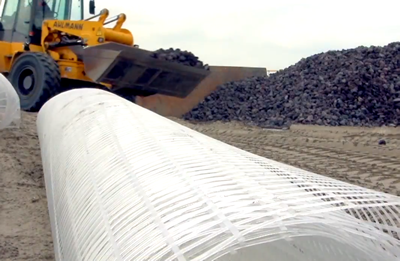9 September 2009 – From March 2008 to March 2009, NAUE GmbH & Co. KG, Germany co-sponsored the construction of test cells for an independent field study of geogrid reinforcement in roadway subgrade stabilization. The Montana Department of Transportation was the other co-sponsor. The study and subsequent forensic evaluation of exhumed materials from numerous manufacturers, which included numerous product manufacturing methods, was carried out by the Western Transportation Institute of Montana State University. The results reveal exceptional performance by NAUE reinforcement materials Secugrid® and Combigrid®.
The data show that welded geogrids, such as NAUE Secugrid and Combigrid, perform extremely well, especially in the critical performance range of up to 5% geogrid elongation, which are critical to the success of a reinforcement geogrid’s survivability. Secugrid‘s individual bars showed a survival rate of more than 99% after significant rutting and traffic passes. When additional passes were carried out to induce rutting and to test failure, Secugrid 20/20 Q1, Secugrid 30/30 Q1 and Combigrid 30/30 Q1 151 GRK 3 outperformed almost all other products in the study, even when rut depths reached 50, 75, and 100 mm.
Due to variations in the site conditions between test sections, an empirical approach was used to normalize small differences in subgrade strength and base course thickness so that a more direct comparison between test sections could be made. Here, the Secugrid products showed their strength and were rated as top-performing soil reinforcing geogrid products.
Ultimate tensile strength is not the only important factor for a safe reinforcement base course design; a very high modulus is just as important. On the basis of the obtained data for the different test sections, the researchers concluded that the performance of the geogrid at a stress/strain ratio in the range of 2% is as important as their robustness. Secugrid and Combigrid excelled in this range. The study found that a tensile strength at 2% axial strain (indicative of the stiffness of the geosynthetic) in the cross-machine direction of the geogrids likely plays a significant role in suppressing rut formation under these conditions. Since Secugrid and Combigrid have excellent tensile strength at low elongation and demonstrate their advantage in the critical elongation ranges, it was clear that they would perform very well under the tested realistic soil conditions, as was seen in the test study.
NAUE Secugrid’s and Combigrid’s advantage is a proprietary manufacturing method that puts uniform strength in all of the material’s extruded, flat polyester or polypropylene bars. Additionally, these high tensile strength bars are structured, which creates a frictional surface that improves frictional performance in soils. The superior stress/strain characteristics of Secugrid and Combigrid, especially in the key elongation range for which many projects must be designed and by which geogrids are often judged, ensures high-quality installations.
The results of the Montana study are available here (PDF)
ABOUT NAUE
NAUE GmbH & Co. KG, active globally in the manufacture of geosynthetics since 1967, is an ISO 9001 certified group of international companies and manufactures geotextiles, geomembranes, GCLs, geogrids, drainage and erosion control materials for all civil engineering and geotechnical applications. NAUE also offers product development and geotechnical advice to assist with the most challenging engineering projects. The company’s global specialties include: filtration, drainage, reinforcement, containment and erosion control landfills, groundwater protection, civil engineering, tunneling, waterproofing and hydraulic engineering. NAUE pioneered the needlepunched method of geosynthetic clay liner (GCL) production of in 1987 and recently received an award in recognition of the company’s activities on development and research on needlepunched GCLs from the International Geosynthetics Society (IGS) for this work. In 1999 NAUE invented a new technology for the manufacturing of Secugrid® geogrids. The reinforcement bars are highly-oriented and uniformly extruded and drawn to achieve a high modulus and high strength at low elongations and are firmly combined in machine and cross-direction to a structurally sound and stable geogrid for soil reinforcement.
For more information about NAUE or Secugrid, Combigrid, and NAUE’s new FourDimension publication series on geogrid reinforcement, contact Kent von Maubeuge in the German NAUE headquarter (kvmaubeuge@naue.com), or visit www.secugrid.com.
RELATED LINK
The Four Dimensions of Secugrid (September 2009)













